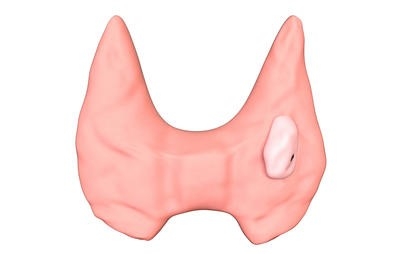Thyroid Inflammations (Thyroiditis)
Thyroiditis are infections of the thyroid gland....

The most common endocrine system cancers are ovarian cancers. Thyroid cancer comes second in terms of frequency. The probability of detecting a clinically significant thyroid nodule is 5-8%. There is a possibility of malignancy in an average of 6% of these nodules. In solitary thyroid nodules, the cancer rate increases to 30%.
In general, thyroid cancers can be examined under 4 main headings: papillary, follicular (including Hürthle cell cancer), medullary and anaplastic cancer. Anaplastic cancer is the most rapidly progressing and highly malignant tumor in the organism; The majority of diagnosed cases do not survive more than 6 months. On the other hand, occult papillary cancers are tumors with the best prognosis and benign behavior.

Unfortunately, the cause of thyroid cancer is unknown.
Rapid growth of the nodule, invasion into surrounding tissues, cervical lymphadenopathy, hoarseness; pain, dysphagia and respiratory distress in later stages are important findings. In patients with a familial history, a history of neck radiation, and hoarseness, the probability of the nodule being cancerous is quite high. The possibility of thyroid cancer increases in vocal cord paralysis, nodules that continue to grow without responding to TSH suppression, nodules in patients under 20 years of age and over 60 years of age, and solitary nodules and nodules with lymphadenopathy.
For this purpose, Ultrasonography, Thyroid Scintigraphy, Thyroid hormones, Fine Needle Aspiration Biopsy, as well as Neck and Lung Computed Tomography or Magnetic Resonance Imaging may be helpful.
Papillary cancers are the most common cancers and have the best prognosis. It constitutes 73-80% of differentiated thyroid cancers. The 30-year mortality rate is given as 6%. It prefers young cases such as the 20-40 age group. It is 3-4 times more common in women than in men. Cervical lymph metastases are detected in 90% of pediatric papillary cancers. Cervical lymph involvement is present in 35% of adults. Advanced age is the cause of recurrence and poor prognosis.
They are usually solid tumors. Cervical lymphadenopathy may accompany the findings.
Although it is accepted that the most limited surgical operation in papillary thyroid cancer is minimal, total lobectomy + isthmectomy on the side of the lesion, the generally accepted view is total thyroidectomy, and if there is manifest growth in the cervical lymph chain, modified cervical lymph dissection.
It is generally accepted that routine adjuvant RAI treatment positively affects survival in papillary thyroid cancers.
Thyroid hormone replacement is an indisputable principle, especially in cases where Total Thyroidectomy has been performed.
It is the second most common form of follicle cell-derived, differentiated thyroid cancer. It is more malignant than papillary cancers and constitutes 15-27% of differentiated cancers. It is often seen in women after the age of 50.
FNAB diagnoses of follicular adenoma or neoplasia are a direct indication for surgery.
The most common way the patient comes to the clinic is with the presence of a palpable nodule in the thyroid. The nodule is a mollusk. It is usually painless. Local compression symptoms (difficulty in swallowing, stridor, hoarseness, dysphonia, pain and distant metastasis) may be observed. In FNAB, the diagnosis can be made as follicular neoplasm. Frozen section may help.
Its prognosis is worse than papillary cancers. A follicular cancer that includes only one of the presence of distant organ metastasis, age over 50, and vascular invasion is considered low risk and has a 5-year mortality rate.
1% is 20-year mortality. In tumors that meet at least 2 of these criteria, 5-year survival increases to 53% and 20-year mortality increases to 92%.
Treatment: The main treatment for follicular cancer is surgery. The treatment of choice should be total Thyroidectomy. If there is lymph involvement, neck lymph dissection should be added.
It constitutes 3 to 10% of differentiated thyroid cancers. It is the oxyphilic variant of follicular thyroid cancer.
There are cervical and mediastinal lymph metastases in 25% of the cases. The incidence of distant metastasis is about 30%. Most commonly Lung, bone, Liver, adrenal, CNS etc. causes distant metastasis.
The treatment of choice should be total Thyroidectomy or near-total Thyroidectomy. If there is lymphatic involvement, modified neck dissection should be performed. Central lymph dissection must be performed in all cases. Tg is an important parameter in the postoperative follow-up of the patient.
External radiotherapy is performed in bone metastases. It has little effect on survival.
Chemotherapeutics such as adriamycin, bleomycin and Cis-platin are used especially in cases with distant metastases.
MTK arises from parafollicular C cells and constitutes 10% of all thyroid cancers; It is a cancer that is more aggressive than other differentiated cancers.
Sporadic Medullary Thyroid Cancer
The most common finding is solitary thyroid nodule. When diagnosed, they often metastasized to the cervical lymph nodes. Dysphagia and hoarseness can be considered as signs of invasion.
Disease 4-5. It occurs in the decade. The female/male ratio is 1.4/1. 1/3 of patients have persistent diarrhea attacks. Additionally, paraneoplastic syndrome (such as Cushing's, Carcinoid Syndrome) may be observed in some patients due to the effect of released hormones.
FNAB is a method that leads to a definitive diagnosis in cases with suspected MTC.
While paratracheal, cervical and upper mediastinal lymph nodes are prioritized in MTC, liver, lung and bone metastases may develop in advanced stages.
Hereditary MTK occurs as a component of MEN 2a, MEN 2b or non-MEN syndromes. They are localized at the junction of the upper and middle lobes of the thyroid gland.
Men 2 is an autosomal dominant inheritance, form 2a MTK, Pheochromocytoma, Hyperparathyroidism; MEN are syndromes characterized by MTC + Pheochromocytoma + Gastrointestinal findings in the 2b form.
MEN 2a
It is a clinical picture consisting of MTK + pheochromocytoma + hyperparathyroidism. It shows autosomal dominant transmission.
MEN 2b
These cases generally have a Marfanoid appearance. Mucosal neuromas are seen in the tongue and subconjunctiva. MTC occurs at an earlier age. It develops at the average age of 16. It has a more aggressive course. When diagnosed, distant metastases especially attract attention.
Familial MTK without MEN
It includes cases that show familial transmission, but no other endocrine pathology or phenotype change is detected. Usually 3-4. It occurs in the decade. Its behavior is similar to MEN 2a in terms of calcitonin levels and regional lymph metastases. Its prognosis is better.
The definitive treatment for MTC is surgery. Standard surgery is total Thyroidectomy + central lymph node dissection.
Increases in Calcitonin levels after surgery may be a sign of the possibility of recurrence. Reoperation may be required.
Anaplastic thyroid cancers are among the most malignant cancers in the organism.
It can be seen in both genders, slightly more in men. The male/female ratio is 1.5/1. Especially in older ages 6-7. It is seen in the decades. It is rare under the age of 40.
In cases, there is usually a fast-growing, hard, large goiter that invades the surrounding tissues. Lymph node metastases are seen in the early stages. Lung and bone metastases are quite common.
Standard treatment should be total Thyroidectomy
Even if total thyroidectomy cannot be performed, freeing the trachea or performing a tracheostomy will prevent the patient from suffocating to death in the future.
The generally accepted trend is to apply hyperfractionated radiotherapy + polychemotherapy (doxorubicin, cis-platinum and 5-FU etc.) after surgery.
Recurrence of thyroid cancer after surgical treatment is considered a recurrence. Although thyroid cancers have a promising prognosis, half of the cases that relapse die because of this.
While regional lymph recurrences are treated with modified radical neck dissection and RAI, local recurrences are treated with Reoperation and RAI. RAI therapy is used in the treatment of micrometastases in the lung and other organs. Thyroid hormone replacement for postoperative TSH suppression is the recommended treatment for all patients.